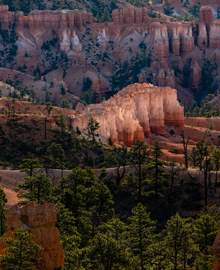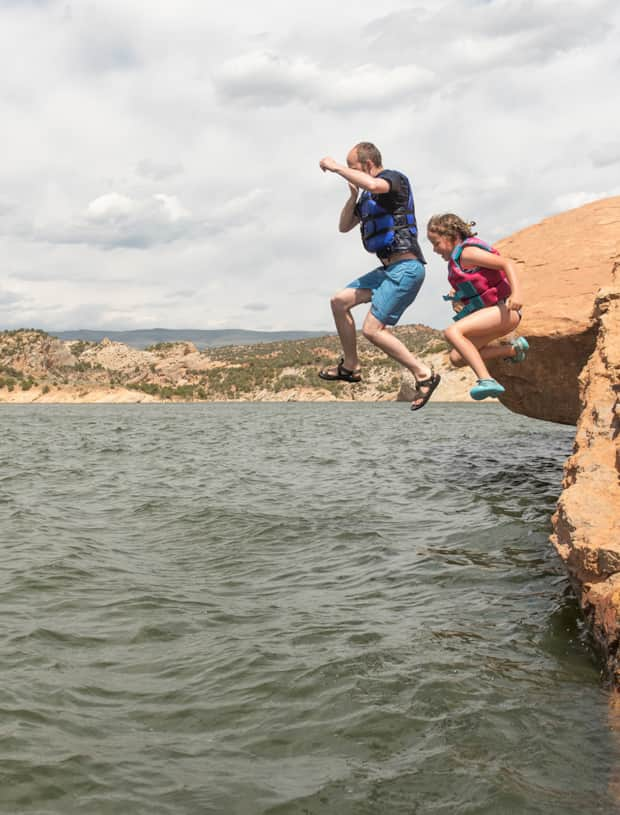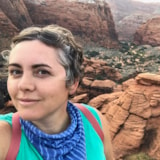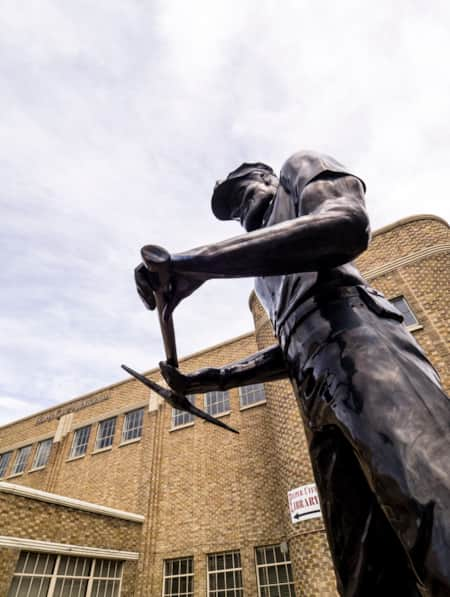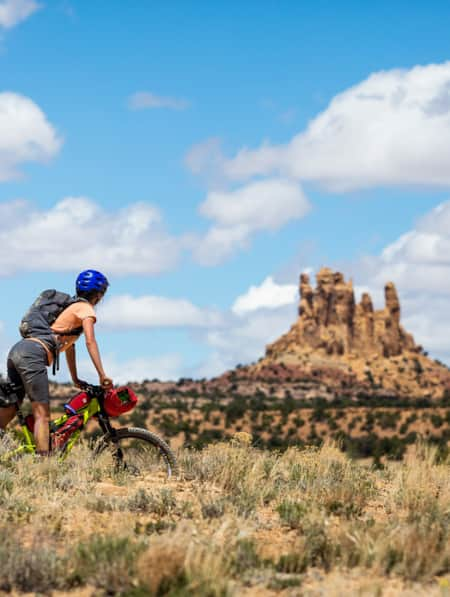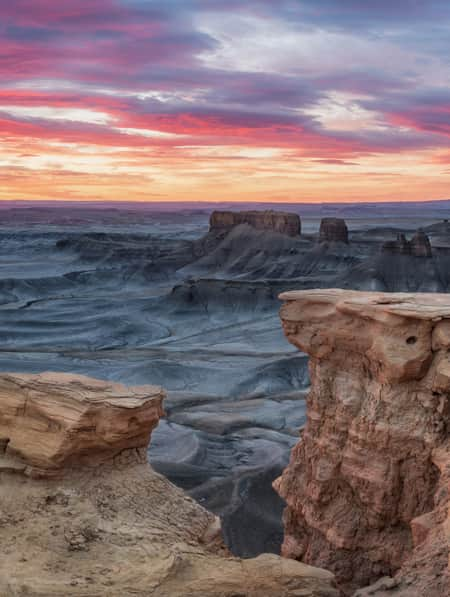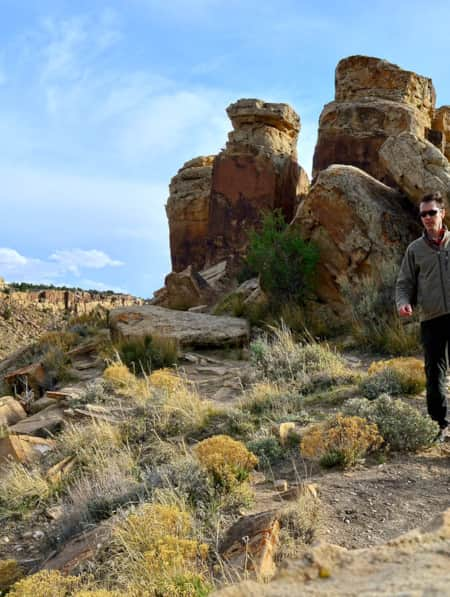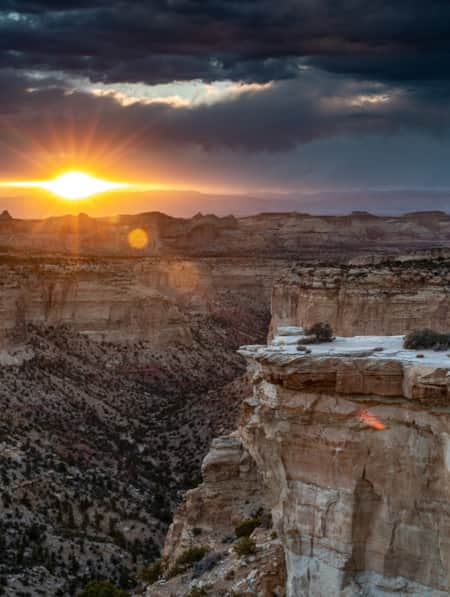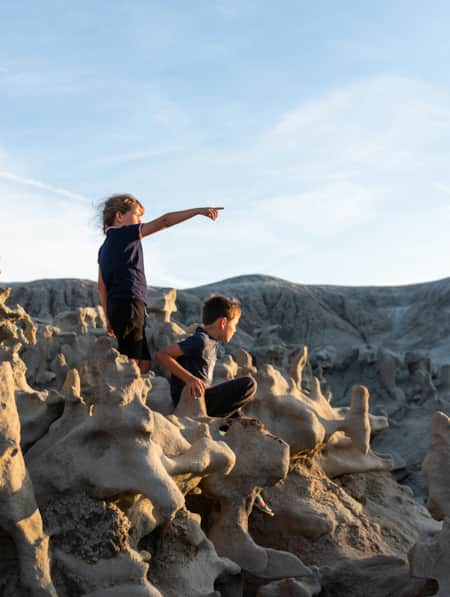A Family Drive Through Utah’s Quiet Places
A vacation where reservoirs and rocks, sagebrush and fossils provide wisdom along the way.
In between sandstone walls and the ancient canyons where dinosaurs once ran, my 7-year old daughter jumps into a bottomless, deep blue body of water, out beyond the sandstone underwater ledge reminding me that really, we are at the precipice of a cliff. As I contemplate my own leap, my little girl jumps out as far as she can, her legs bent out behind her in the air.
Her bravery surprises both of us and I jump, too. As she bobs in the water, her two French braids, wild and wet, drip with cold water, the sun warming us. Her bright pink life vest bunches near her shoulders. She looks around, and we are completely alone, suspended between the water and sky. She says, “For a minute, every single thing was quiet.” She looks so small against the backdrop of the canyon wall behind her.
We moved back from California to Utah because we wanted our children to know this place. To know what it is to venture out into the wilderness, beyond freeways, suburbs, shopping centers. We wanted to arrive, again and again, at the place where every single thing is quiet. (Read: Why Your Kids Need a Utah Trip)
"We wanted to arrive, again and again, at the place where every single thing is quiet. "
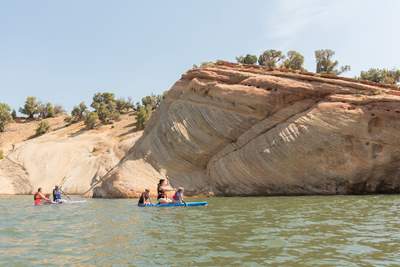
My daughter isn’t wrong: A trip into the rural deserts and canyons of Utah is a quiet pause. It’s a descent into geologic time that puts me squarely in my place — a blip in a layer, a bystander of miracles. I grew up here, I am protective and unwilling to exploit the secrets I know about this land, but I also know that the land will reveal itself anyway for any person willing to also be quiet, to put down the camera, the schedule, the rush. Utah offers quietude because it holds billions of visible years of wisdom and experience; it has no need to prove itself.
There are five of us in our minivan full of camping gear on this trip. By all standards, we are a young family, three kids, two old enough to tease each other relentlessly in the back seat, and one napping in her car seat. We want and need family moments that aren’t an expensive plane ride away. We want time together that doesn’t require consumption and crowds. It is important to us as parents that we show our children what we value by taking them to the places where they can experience awe.
I travel with my favorite nature writers on my shoulder — Robyn Wall Kimmerer, Annie Dillard, Mary Oliver, Wendell Berry, John O’Donohue. I think of their deep reverence for being immersed in a place and an experience without needing to immediately say what it means or share it on social media in a performative way. I think of their examples of treading thoughtfully and lightly where they found themselves. Utah is not a place to be conquered, to be scrambled across for a photo op, to be rushed. Terry Tempest Williams writes: “To be whole. To be complete. Wildness reminds us what it means to be human, what we are connected to rather than what we are separate from." (Read more on how to travel responsibly, a shared ethic called Forever Mighty.)
Dinosaurs Aren’t Just a Story We Tell
Location: Vernal area
I am a writer and artist, my husband is a geologist. It seems imperative that we take our children to the forgotten corners of Utah so they know not just how big the world is, but how incredibly old and wise. (For more details on the drive, see the companion itinerary: "Sandstone Spires & Swimming Holes") On our first day, there’s a cloud of dust behind our minivan on a long dirt road in the northeastern corner of the state at dusk. My children point out the flames that mark each oil field that flank us. They are silent omens to remind us that humans will always make their way into the wild. The oil drills bob their heads as if to urge us along. Pronghorn antelope lift their long faces and watch us as we pass; they feel almost as foreign to me as the machines dotting this part of the state. Except when the drills are pulled from the dirt, when the wells are empty, the antelope will stay.
We are listening to The Cure, not speaking, but singing the words when to the side of us, there are three wild horses. Three wild horses, one copper and spotted with white, one black and the smallest, a chestnut brown, and there are hardly words that could capture them. It’s nearly the summer solstice and days seem stretched into what my children will claim as memories. I was taken by these same horses hours before, but then they were too far away for me to see the muscles across their backs. Now, the copper one turns back to the black one and pushes its nose to the other’s neck before they run out into the endless expanse of desert. It’s as if a piece of my heart leaps through the car window and chases them and their wildness. From childhood, my whole life has turned on moments that feel unseen by anyone and sublime in a way that form my understanding of this world.
In a nearby reservoir the next day, we paddle across the water to a red sandstone rock that dives slanting into the water. My youngest daughter places her hand in a dinosaur footprint and her palm hardly fills even a quarter of it. I am struck by how clear the footprint is and how clear it is that these footprints follow the slanted slab right under the water. It was once flat and a herd of raptors moved across this land when it was more like tropical landscape, humid and cool. My son asks what color these dinosaurs were, and I tell him his guess is as good as mine. There is both evidence of the shifting earth here at the edge of the Colorado Plateau, and an abundance of proof that dinosaurs are not just a story we tell, but some other earth in some other time that we now get to share. Because it’s hard to wrap our heads around billions of years behind us, we jump off the cliffs into the impossibly deep water, again and again, and perhaps the exhilaration of this act is just as important.

Red Fleet State Park
Photo: Clark Goldsberry

Moonshine Arch


A Land Wiser and Older Than Us
Locations: Book Cliffs, San Rafael Swell
From Vernal, we drive down through the Ashley National Forest. Incidentally, in 1984, my parents drove to this same place from Salt Lake City to cut down a Christmas tree. My mom was eight months pregnant and I got my name that day.
It feels as if we are driving in an entirely new land as we descend along the eastern edge of the state. The rocks are no longer the swirling cliffs of orange pastels that followed us through dinosaur land, but they are layered like a giant birthday cake. These rocks are limestone, fossilized evidence of the ocean that once covered this land.
As we wind down into the cities, we stop in Helper, which I imagine is what Park City was like before the stardom and ski resort wealth. Art galleries line the main street. In the backdrop, the Book Cliffs house the coal mines that once kept this city alive. (Read: “Turning Carbon into Culture.”)
As we move beyond Helper, we come to the flat lands that lay between the Book Cliffs and the San Rafael Swell. Millions of years ago, this land was not worn down to a flatness, but was uplifted enough that a river system running through did not go south, or north, but rather, straight through the mountain, carving a canyon as it flowed. I am taken by the difficulty of carving a river through a range of mountains, even when aided by gravity. It is details like this that offer me a personal connection to this wilderness. Surely, we in some way are descended from such persistence.
We stay the night in Green River, spending both the evening and returning in the morning at a nearby Crystal Geyser that never actually erupts while we are there. It doesn’t matter, as this landscape and the evidence of the geyser makes us feel as if we are on another planet. The geyser, discovered accidentally by an oil drill decades ago, is a cold water geyser driven by mechanisms of chemistry, rather than heated pressure. It sounds like a giant can of soda when you put your ear to the pipe. My children are exhilarated by this simple noise in the midst of so much silence. They move close to the pipe, then back away, again and again. To be a part of this secret is a privilege, a reminder that perhaps the very point of travel is to ask of ourselves a moment of quietude, that then begets gratitude.

Main Street in Helper
Photo: Andrew Burr


Crystal Geyser
Again, on a dirt road, the drive out at sunset is full of colonies of boulders. I picture them like communities that care for this desolate piece of desert with fortitude. As we drive beyond the many peaks guarding the geyser, the Book Cliffs almost startle me with their size. The night before the air hadn’t been clear, maybe a fire somewhere, and I’d only seen their shadows. But now, on this bright, windy morning, they are majestic. Millions of years ago, they did not reign over this flat land, but today, I turn around in my seat twice as we drive away, just to see them again, to pay a little tribute to their current reign.
We wind further south, in the distance, I recognize the San Rafael Reef, a jagged span of cliffs looking dagger-like and shoved at an angle into the ground. It’s as if they are guarding a secret, the place at the middle of the swell, the most ancient part bubbled up from the earth finally showing itself. I am humbled to think of the places I have walked on and touched without realizing, or even given a second thought to their history. Out here it’s hard to ignore that we are treading on ground so much wiser and older than us.
We stop at the place where Marie Curie gathered uranium for her experiments. There are remains of a small log cabin, and in the background, below the white crags of Temple Mountain, you can see the remains of the mines. I tell my children that miners and their families once zigzagged across this harsh environment, only to work and gather what was ultimately an even harsher element.
Just down from here, the remains of a 100-foot long petroglyph panel done by ancient, native people sits nestled in the shade about 60 feet up. For most of my life, I’ve thought of time in terms of when Jesus was around, but science places these inscriptions, some eight feet tall, as far back as 1,300 years before Christ. Again, a silence. What remains of these ancient markings, some of the uranium even mixed into them to create yellow hues, have stood guard, have watched the moon move from new to full month after month, and will hopefully protect this place long after we are gone.
After, in Goblin Valley State Park, my kids run through the hoodoos like a playground, then pause in the shade to ask, “How did these rocks get here? Why do they look this way?” It’s clear that the desert cares little for our survival, but somehow not so little to not offer a thousand troves of treasure in such a desolate land. I ask my husband if the hoodoos will be around for a lot longer, thinking that somehow, the thousands of people that climb them each year might best their ability to survive. He says they might erode sometime in the next million years.
"It’s clear that the desert cares little for our survival, but somehow not so little to not offer a thousand troves of treasure in such a desolate land."

Goblin Valley State Park

Hiking to Water
Location: Capitol Reef National Park
At this point, we’re four days into our road trip and are fully committed to our family motto: Stop while we’re ahead and don’t make our kids do anything miserable, and therefore, parents miserable (Read: “Wheeling It: An RV Primer for Utah Family Trips”). We avoid hikes with big vertical inclines, opt for shady trails, and seek water where possible, because there’s something innately alchemistic about jumping into a body of water on a hot day.
Capitol Reef National Park is a place I’ve come for solace before, often with a young child riding on my back. We hike up Sulphur Creek behind the visitors center and within a few hundred feet, we run our hands along the undersides of overhangs and lean down to see hundreds of fossils of life on a long-dry river bed. The end of our mile-long hike doesn’t disappoint. Five minutes after arrival, and every member of my family has jumped from the waterfall cliffs into the pool below. Before jumping in each body of water, I stand on the edge and take a deep breath. I know the initial moments will be the shock of cold. That brief, full immersion into pools where you cannot always see the bottom is an insistence on paying attention, to being fully present in this moment. In the afternoon light, the reflection of the water waves down at us from the top of the 30-foot rock wall, the blue sky, the puffy clouds peeking in at us swimming and jumping. This, I think, is magic, as I stand dripping in my wet clothes. I am grateful that for a minute, every single thing is quiet.

Capitol Reef National Park
Photo: Clark Goldsberry
"This, I think, is magic, as I stand dripping in my wet clothes. I am grateful that for a minute, every single thing is quiet. "
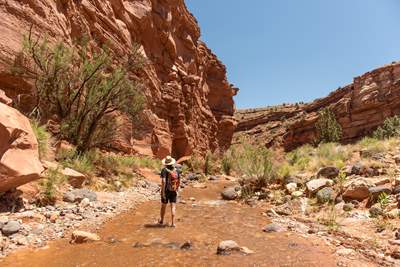
The final stop of our trip reminds me of the way we began, at the end of a long, dirt road that may as well be another planet. A slot canyon holds us inside of its smoky-colored sandstone walls. We didn’t even remember it was 100 degrees in the sun. My children each hold a ball of mud in their hands, cool and smooth, and here, to them, it seems vital to somehow preserve.
And now, back home, with bills in the mailbox, laundry that isn’t folded, a lawn that I will mow, many of these places seem otherworldly. There’s some expanse between us. Those places are still nestled somewhere in my heart, some meeting between the abyss of what is, and what I believe is possible. I go to these places because I glean for years on their silence. One of my favorite scenes in Terry Tempest Williams’ book “When Women were Birds” is when she sees a rare bird that no one believes she could have seen. Her grandmother, an educated birdwatcher says: “You know what you saw. The bird doesn't need to be counted, and neither do you.”
And so it is with the wild mysteries that make up the state that I grew up in, and the one my children are now growing up in. Just fifteen minutes from my house there is a canyon park called South Fork, with a simple stream running through it. The water is snow run-off, so it’s always frigid. My children do not care though; their warm bodies splash, wade and play in this water. I see the way they mutually bless each other — the stream and my children. I hold tightly to that rare understanding that only happens in nature, the one where we make a pact with each other, to not reveal all our secrets, but rather, to revel in the silence of keeping them.

Willis Creek Canyon


View Millions of Years of Geologic History in an Afternoon
Unlock new levels of understanding about the land you are traveling through, around and on by learning about the geology in Utah.
What's Nearby
-
Ashley National Forest
Elevations in the Ashley National Forest range from 6,000 feet to over 13,500 feet. The crown jewel of this forest is Flaming Gorge National Recreation Area.
-
Flaming Gorge National Recreation Area
With more than 200,000 acres of land and water, Flaming Gorge is a scenic playground for boating, waterskiing, windsurfing, camping and backpacking in addition to some of the best fishing in the west.
-
Red Fleet State Park
Known as “Little Lake Powell,” Red Fleet State Park offers fishing, hiking, camping, biking and more in a gorgeous sandstone lake setting. Plan a trip!
-
Steinaker State Park
Utah’s Steinaker State Park offers outdoor action for everybody. Swim in the reservoir, camp, bike, paddle, wakeboard, ride ATVs and more! Check it out now.
